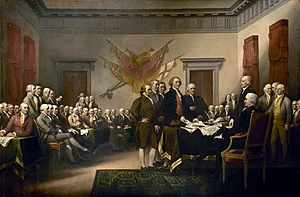Orange County, California recently decided to change the name of its airport, which had been named after John Wayne, the cowboy actor who died in 1979. And of course, take down his statue.
A lot of you may not be familiar with the kinds of roles he played, which were almost exclusively Westerns and “war” movies, mostly from World War II. (For those of you who read, that was a war America fought to defeat Hitler’s Germany and Japan’s Imperial military, 1941-1945. It was a common subject around the dinner table when I was growing up.)
I only want to relate here the impact John Wayne had on most of the western actors that came after him, for was the model of what they used to call “the strong silent type”, the man’s man. Let’s just say that strikes a common chord in most males, even today.
So, westerns today, if they want to be popular, still have to employ that same type of hero. Why? Simple, it sells to the audience, which are still young men, but also middle aged men such as my sons, the Star Wars generation, now in their 40s. They still watch John Wayne’s better films, all the way from his first Big Screen hit, “Stagecoach” in 1939 to “The Shootist” in 1976, both among his finest.
Someone dug up an interview Wayne did with Playboy in 1971 in which he singled out Angel Davis, an avowed Communist from the Vietnam War era, and even for black folks in general, one of the most despicable humans who ever breathed, about which her race has nothing to do. That, and a misquote about “white supremacy” but which would have been considered culturally liberal in Democrat-run Jim Crow states in 1971, is all that Orange County needed to strike his name.
Orange County is deeply red, but Dems stole the county in 2016, and since I expect this purging of John Wayne to be straw that breaks the camel’s back in Orange County, turning back red, I take a certain amount of joy in watching the county government shoot itself in the foot this way. So really have nothing more to say about it. A win for the good guys.
I only want to talk about how, over the years, young black men have received John Wayne. Black men my age, and we frequently talk about movie heroes, saw many of the John Wayne films of the 60s, such as “The Alamo”. He did a series of US Cavalry-Indian Wars films with John Ford in the late 40s-early 50s, all classics, which people still watch on Turner Classics and other places. In all those films, all the way into his later years, such as “McClintock”, he always played the same role as speaking out for tribes as they had to wade through the waters of federal reservation agents, always portrayed a weenies, and gun-runners and whiskey sellers always trying to get the tribes liquored up to go off on a rampage.
So John Wayne, the “Western actor” was always the image of defending the native American’s way of life, as something noble. And since he had two Mexican wives, covering most of his film career, he certainly had to bias toward Latinos. I think he had six kids by them.
So how did John Wayne come across to black men not just of my generation, but the men would be in their late 40s today, and maybe even their sons, who would be in their 20s?
I got to find out in the early 90s, while living just across the river from Cincinnati. I forget the reason for visiting Blue Ash, which was a northern suburb where the giant I-275 beltway around Cincinnati joins up with I-75 north to Dayton, Toledo and Michigan. It was Saturday, and on the way home, from the big marquee sign of a mall, I saw the film “Tombstone” was playing, and, being about the Earps, I decided to drop in and see the playtimes. The 1 PM matinee was about to begin so I went in and took a seat.
It was only then that I noticed that this was a black neighborhood. And I was the only white guy in the theater. And looking around I didn’t see a single woman, either. So I figured this was Dad’s day out with the boys, or maybe even Dad’s visitation day, as was a common sight in those days in every neighborhood theatre.
The theatre was half full, which for a matinee, was pretty good. Everybody, except me, sat in groups of 3 to 6, usually a couple of taller heads and smaller heads. Each group was “socially distanced”. I admit I was a little surprised. I don’t think I’d ever seen very many black people seeing a cowboy movie, and here was at least a hundred.
There were a lot of memorable scenes from that film, manly scenes if you will, and all you have to do is Google “Tombstone” and click on videos and most them appear. I use the “Hurts, don’t it?” line often on Twitter, of Wyatt grabbing a quirt away from a railroad agent whipping his he tried to take the horse off the railroad car, and then quirting the agent. And my oldest son still uses the “cocked pistol to Ike Clanton’s forehead” as his signature “I mean it, End of discussion” picture in several contexts.

As an outsider-observer it was very gratifying to me to see black fathers and sons cheering and clapping in exactly the same places I would have cheered and clapped had by boys been with me.
The point is, “Tombstone” was simply an extension, a well-played extension, of a model first created and perfected by John Wayne.
And black men loved it 25 years ago, and, if fathers have anything to do with their children’s growing up, they still do.





